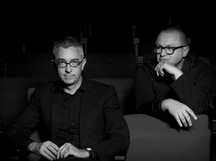After being presented at the Opéra de Grand Avignon and the Opéra national de Bordeaux, the production of Rusalka staged by Clarac, Deloeuil > le lab makes a stopover at the Opéra de Nice!
Here are just a few of the many excellent reviews that have appeared in the press:
“Never losing sight of and therefore accepting, even assuming, the letter of the libretto – rather than by passing or diverting it – requires a certain effort, which the French directing duo Jean-Philippe Clarac and Olivier Deloeuil never shy away from. This, while maintaining the necessary distance to make it resonate with a contemporary narrative and contemporary themes. Without, however, falling into the trap of an endlessly reproducible reading grid, but, on the contrary, always finding an original angle (...). Here then, for this new Rusalka, the water nymph is immersed in the merciless world of synchronized swimming (...). Everything about the action, its driving forces and motivations, right through to the denouement, is absolutely right.” (Opéra Magazine, link)
“True to themselves, the duo did not confine themselves to updating the work: they have superimposed onto realism the dreamlike world of Dvorak's "lyrical tale". While the videos, perfectly integrated into the set design, show modern-day swimmers, with an aquatic ballet reminiscent of Esther Williams movies in Act II, they also feature images of the seabed and lakeside landscapes, establishing the symbolic omnipresence of primordial water throughout. The universality of the message is thus preserved, even reinforced, in this perpetual oscillation between dream and realiity, tale and news story, pond in the Médoc and swimming pool in Avignon (...). Here as elsewhere, in their Mozart-Da Ponte Trilogy in Brussels for instance, the two directors do not sacrifice the theatre to the singularity of the concept or the skill of the production. They create beings of flesh and blood, restoring their complexity, from a Rusalka trapped in her mermaid suit, both rebellious and submissive, to a Foreign Princess of vampiric seduction.” (Diapason, link)
“After Butterfly in the streets of Limoges, Aschenbach in those of Strasbourg and Serse in a skatepark in Rouen, it is in a swimming pool in Avignon that the two accomplices decided to immerse Dvořák's siren. This provides the opportunity for a virtuoso plunge into that pivotal moment when a girl must, wants to and will become a woman. This is made clear at the start of Act II by the voice-over of the heroine confiding her intimate doubts about the recurrent injunctions to femininity in the charter of the sport she has made the passion of her adolescent life: synchronised swimming. In a libretto that spoke about "becoming a human being", Clarac-Deloeuil choosed to read "becoming a woman", bringing to the surface "You're not born a woman, you become one" and others "Be beautiful and shut up!” well-known in the current battles for gender equality. An approach that in no way contradicts the spirit of a work that is all about that.” (Resmusica, link)
"Since a very tactful revisiting of Berlioz in Poitiers several years ago, Jean-Philippe Clarac and Olivier Deloeuil have confirmed their obvious ability to make things clear, where worn-out, systematic, if not dubious, theatrical elucida-tions are often rife. The argument for their staging is first of all its clarity: the Olympic pool and the world of synchronized swimming ath-letes, who also play an active part in the scenography, are all the better inserted into Dvořák's opera because the very figure of the naiad underlines the background from which the heroine, Rusalka, comes. She should accept to swim among her peers, away from any human presence, far from men who might defile her. The liquid element is omnipresent, all the better suggested by the swimming pool, shown in cross-section and open towards the audience... The main action takes place there. So, incidentally, water occupies the space of the auditorium and symbolically immerses the spectators (...). One of the obvious successes, underlining the fusion between the operatic subject and the directors' vision, is the video of swimmers in synchronized action during the orchestral interlude that introduces the choral scene at the Prince's court: this aquatic ballet, in complete osmosis with the score, further enhances the soundness of this transposition.” (ClassiqueNews, link)
10.01.2024
